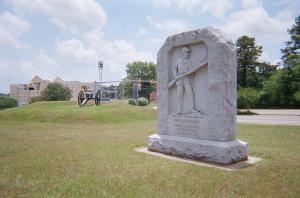47th Indiana Infantry Monument at Vicksburg, Miss.
Eli Swihart was born February 25, 1820 in Ohio. He was the son of Peter and Elizabeth (Palmer) Swihart.During the 1850’s some of the Swihart family stared to migrate west into northern Indiana. By 1860 Eli and his wife Elizabeth (Goble) owned a farm in Turkey Creek Township, Kosciusko Co., Indiana with their five children Mary Jane, William, Lucinda, Lydia A. and Samuel L. During 1861 the Civil War had started, it appears Eli was more interested in his family and their farm than enlisting in the Army at his age. Although one of Eli’s younger brothers, George had already enlisted in the 89th Indiana Infantry in Jay Co, Indiana. During 1862 the Federal government instituted the draft. In October of that year Eli was notified that he had been drafted for a period of nine months. On October 16, 1862 Eli Swihart at 43 years of age, reported for duty. He along with several others from Kosciusko Co. were placed in company D; 47th Indiana Infantry Regiment which was already in the field.
Eli and the rest of the new men would be shipped south to Helena, Arkansas were the 47th Regiment was stationed until the end of February 1863. In March the regiment was sent to General U.S. Grant, who was building the army up for a push to take Vicksburg, Mississippi. April 30th, 1863 the 47th Indiana, along with the rest of the army crossed the Mississippi river and landed at the little hamlet of Bruinsburg and started to push inland. On the morning of May 1, the regiment found itself at a place called Port Gibson. Confederates were found in strong defencive positions; while the terrain in the area did not allow much manuvering room to attacking troops. The Union Army attacked and Eli saw his first action. By evening the Confederates had withdrawn, but the battle at Port Gibson had been a hard back and forth fight for both sides; the 47th Indiana had played a large roll in the fight. Grant continued to push into Mississippi, going through Raymond and Jackson. As the army was getting close to Vicksburg, the Confederate Army was making plans to push Grant away for good by massing troops for an attack. On May 16 the Confederate Army was found near a place called Champion Hill around Baker’s Creek. This would prove to be the battle for Vicksburg; Eli and the 47th Indiana found themselves engaged in heavy combat, sometimes hand to hand throughout the day. The losses were heavy for both sides, but the Union Army had pushed the Confederates back to their Vicksburg defences. By late May Grant was at the gates of Vicksburg, on two separate occasions he tried to take the city by force and was pushed back each time. The Army settled in for a siege during some of the hottest months in Mississippi. Eli and the 47th Indiana would be digging trenches for their protection and approach trenches toward the Confederate works. The regiments position was across from Fort Garrott, a strong Confederate earthwork. From late May and throughout June Eli would find himself under fire almost daily and exposed to the elements of a Mississippi summer. On July 4, 1863 the city of Vicksburg had fallen, the soldiers of the 47th Indiana must have been very excited at the Confederate surrender. Eli had lived to see Vicksburg fall and must have been thinking about going home as his time in the army had almost expired. July 16, 1863 was the day Eli had been waiting for, he was discharged honorably and would be sent home.
It is not known when he arrived home or how his health was, but seeing his family again must have been a joyous moment. Sadly on August 23, 1863, after living through the marches, battles and trench warfare of the Vicksburg Campaign, Eli Swihart died at his home. It would have been easy for Eli to have avoided the draft or deserted somewhere along the trip south. He must have felt a sense of duty, his government had called him and he would serve. In his nine months of service Eli saw more action than some soldiers did in four years, unfortunatly for his family, the campaign took years off of his life. Eli was laid to rest in Mock Cemetery, Kosciusko County, Indiana.
Written By Scott Busenbark






Recent Comments